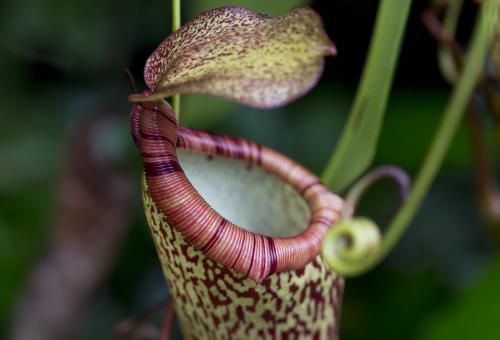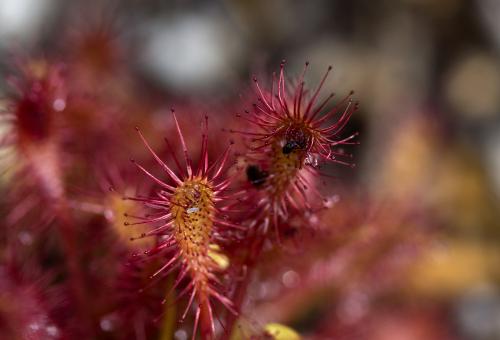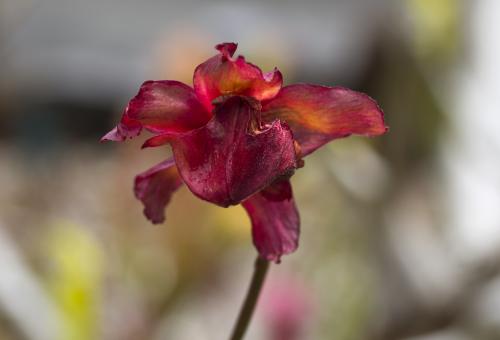Wild banana
Cultivated around the tropics, there are about 1,000 types of banana.
From specimens that snap shut to individuals that curl up, carnivorous plants are expert meat-eaters.
This group of 400 or so species has cleverly adapted to living in poor soil – getting their nutrients from insects and the like instead. We take a look at five of the most fascinating…
Nepenthes
Native to: Southeast Asia
How it works:
The pitcher’s vase-like leaf produces and contains a sweet liquid in which the plant drowns its prey. Ants and flies are attracted to the plant’s colourful appearance and victims often make the lethal mistake of landing on its very slippery lip… Once inside, it’s nearly impossible to escape from the trap’s waxy coating. The plant is then able to digest the prey and extract is nutrients.
Eating habits:
The pitcher mostly feasts on insects such as ants and flies, but animals as big as rats and frogs have been known to accidentally fall into the pitcher!
Freaky fact:
Some insect larvae can thrive inside the pitcher’s trap, while animals such as frogs and bats use the plant’s lid structure to shelter themselves.
You can come and have a look at these clever plants at Eden! The Highland tropical pitcher plant (Nepenthes spectabilis x ventricosa) grows in our Rainforest Biome.
Dionaea muscipula
Native to: wetlands of east coastal US
How it works:
With leaves that snap shut as soon as prey touches their ‘trigger’ hairs, the Venus flytrap is one of the only plants on earth that moves right before your eyes! It’s still not confirmed how the flytrap actually moves, but it may be that it’s caused by an electrical current moving through the plant’s cellular structure.
Eating habits:
The flytrap eats a variety of insects and is especially fond of grasshoppers and spiders.
Freaky facts:
A flytrap leaf can snap shut in under a second! However, each leaf can only snap shut three to four times over the flytrap’s lifetime.
Despite its name, only about 5% of the flytrap’s diet actually consists of flies.
Interested in growing your own Venus flytrap? We have a handy seed kit that has got everything you need to grow one.
Drosera
Native to: all continents except Antarctica
How it works:
Often described as ‘living flypaper’, the sundew has tentacle-like leaves which are covered in sticky, glandular hairs. The plant’s tacky secretion gives off a sweet scent, which attracts insects. Once an insect is stuck to its leaf, the sundew will curl inwards to start digesting its prey.
Eating habits:
The sundew eats all kinds of insects, including flies, spiders and mosquitoes.
Freaky fact:
Some species of sundew can bend their leaves inwards in just a few seconds after contact with an insect; others can even do so in mere tenths of a second!
Darlingtonia californica
Native to: California and Oregon, US
How it works:
The cobra lily attracts insects with its scent and the sweet nectar on its ‘tongue’, which is cleverly highlighted by sunlight shining through a transparent area on its upper lid.
Once an insect has ventured inside the lily’s tube-like leaf structure, the plant’s slippery secretions and downward hairs cause the insect to fall into the lily’s trap, where it’s then slowly digested.
Eating habits:
The cobra lily enjoys eating insects such as beetles and flies.
Freaky fact:
The cobra lily gets its name from its unusually shaped leaves, which resemble the rearing head and forked tongue of a cobra.
Utricularia
Native to: all continents except Antarctica
How it works:
Mostly found living in lakes and rivers, the bladderwort has a floating stem with tiny sack-like traps growing along it. These traps, or ‘bladders’, have clever door-like valves that open and shut within thousandths of a second when triggered.
A bladderwort’s trap works by pumping water out through its walls, which builds pressure and ‘sets’ the trap like a spring. Long hairs attached to the trap act like levers and, when an insect touches one of them, the bladder’s door will open and suck in a stream of water – and the insect along with it! When the trap is full of water, the door closes again and the plant digests its prey.
Eating habits:
The bladderwort likes to eat lots of different aquatic species, such as mosquito larvae, water fleas and even young tadpoles.
Freaky fact:
With its traps able to snap shut in as little as 1/35th of a second, the bladderwort is 100 times faster than the Venus flytrap at catching its prey!




